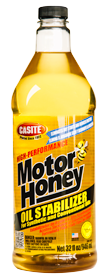It’s not unusual for cars to get worse fuel economy as they get older. The more odometer miles, the fewer miles per gallon. But why? And how can you get those lost MPGs back?
What Causes Cars to Lose Fuel Economy as They Age?
If your car gets fewer miles per gallon than it did when it was new, there are a few potential reasons:
- A dirty engine.
Also known as “engine deposits” or “build-up,” this happens when carbon soot or contaminants build up on surfaces inside the engine or exhaust. The grime can clog fuel injectors or intake valves, foul spark plugs, or coat the sensors that help your car manage fuel consumption. Any of those problems can reduce fuel economy. - Increased friction.
Over time, parts can become worn and not move as freely as they once did. When this happens, the increased friction can slightly affect overall fuel economy. - Decreased compression.
Wear within the engine valve seals or piston rings can also decrease compression in the cylinders. As the fuel within the cylinders burns, it produces pressure, which pushes the pistons downwards and creates the movement that powers your car. When parts become worn, some of that pressure can “blow by” the piston rings, which means some of the engine’s power is literally leaking out. - Changes you’ve made to the car.
Have you added a roof rack or spoiler? That will affect wind resistance. Have you accumulated a lot of junk in the back seat or trunk? It takes extra gas to haul around extra weight. Have you changed the style or size of the tires? That can increase wind resistance, or affect how accurate your car is at counting the miles (larger-diameter tires will make your car think it’s traveled fewer miles, which will make it look like it’s getting lower gas mileage, even if it’s not).
How to Improve Fuel Economy
One way to improve gas mileage is to change your driving habits: accelerate less quickly, drive slower, etc. Those tactics do help save gas, but they don’t address the root mechanical problems that are hurting your fuel economy. How do you fix those problems?
Some of them are pretty obvious. If added weight is the problem, get that 50-pound toolbox out of the trunk and leave it at home. If a roof rack is causing extra wind resistance, you can either learn to live with it or take it off when it’s not in use (which is easy with some roof racks, and not so easy with others).
If engine deposits are the problem – and they usually are the problem, or at least part of the problem – then a high-quality fuel system cleaner is the easy solution. (The hard solution is to take apart the engine and clean it all by hand, so we prefer the easy way.) Motor Honey Complete Fuel System Cleaner is designed to clean injectors, carburetors, intake valves, and really the whole combustion chamber. All you have to do is add one bottle to the gas tank, about once every 3,000 miles.
If the problem is friction or compression, you have a couple of options. One is to completely rebuild or replace the engine. This is obviously a bit extreme; though it will likely improve your fuel economy, it would take years for your fuel savings to cover the cost of the repairs. The more reasonable option would be to simply use some oil stabilizer in your engine. Motor Honey Oil Stabilizer reduces friction within your engine, and it helps prevent the blow-by leakage that robs your engine of power and reduces fuel economy. The oil stabilizer is added as part of your regularly scheduled oil change, and doesn’t cost much more than plain motor oil.
You can find either of the Motor Honey products at these stores.


